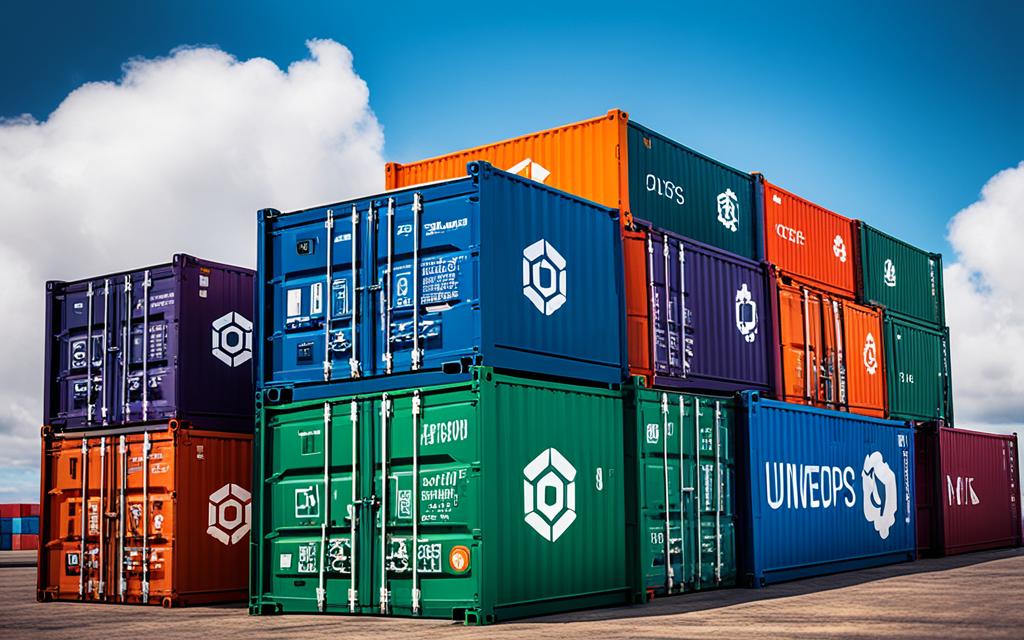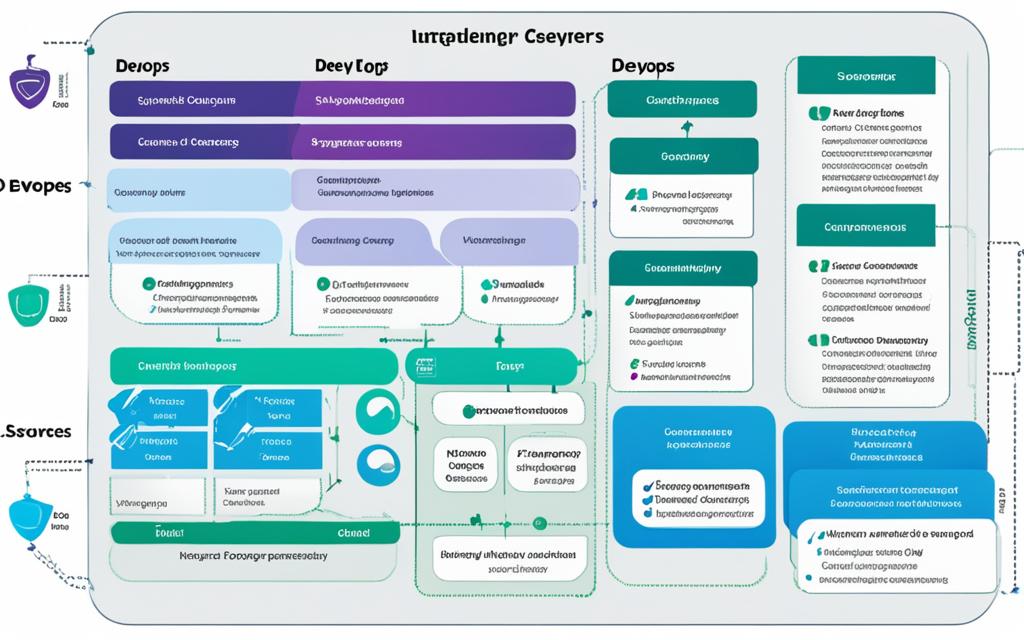Cloud DevOps tools play a pivotal role in managing and optimizing the infrastructure of cloud networks. By leveraging these tools, organizations can enhance collaboration between development and operations teams and automate software development processes, resulting in improved efficiency and productivity. In this article, we will explore the core components of DevOps, highlight the top DevOps tools for cloud network management, and discuss the significance of version control systems, containerization, and infrastructure as code. Let’s begin our journey into the world of DevOps tools and their contribution to network management.
Core Components of DevOps
The core components of DevOps are essential for driving successful implementation and achieving efficient cloud network management. These components encompass key principles and practices that enable organizations to foster collaboration, embrace automation, and continuously improve their software development processes. By understanding and implementing these core components, businesses can optimize their DevOps workflows and enhance their overall performance.
Culture and Collaboration
Building a strong culture of collaboration is at the heart of DevOps. It involves breaking down silos between development, operations, and other teams, encouraging effective communication, and fostering a shared sense of ownership. Collaboration ensures that everyone is aligned towards a common goal, which leads to faster problem-solving, increased efficiency, and improved overall productivity.
Automation
Automation plays a vital role in DevOps by eliminating manual, repetitive tasks and allowing teams to focus on more critical aspects of software development and network management. Automated processes help streamline workflows, reduce errors, and ensure consistent results. By leveraging automation tools, organizations can achieve faster deployments, improved scalability, and enhanced reliability of their applications.
Continuous Integration (CI) and Continuous Delivery (CD)
Continuous Integration (CI) and Continuous Delivery (CD) are key principles in DevOps that enable frequent and automated software releases. CI involves frequently merging code changes into a shared repository, validating these changes through automated testing, and providing immediate feedback to the development team. CD ensures that software is always in a releasable state by automating the entire deployment process, from building to testing to deployment.
Microservices and Containerization
Microservices architecture and containerization are essential components in modern software development processes. Microservices allow applications to be built as a collection of small, independent services that can be developed, deployed, and scaled independently. Containerization, often powered by tools like Docker, provides a lightweight and consistent environment for running these microservices, making deployment and scaling more efficient.
Infrastructure as Code (IaC)
Infrastructure as Code (IaC) is a practice that involves defining and managing infrastructure components through code, ensuring that infrastructure provisioning and management is treated as a software development process. Tools like Terraform, AWS CloudFormation, and others enable teams to codify their infrastructure, allowing for version control, efficient deployment, and easy scalability.
Monitoring and Feedback
Continuous monitoring and feedback loops are crucial aspects of DevOps. Real-time monitoring tools allow organizations to gather data on application performance, network health, and user experience. These insights enable teams to identify potential issues, proactively address them, and gather feedback to continuously improve the software and network infrastructure.
Security (DevSecOps)
DevSecOps emphasizes integrating security practices throughout the DevOps lifecycle. It involves implementing security measures at every stage of development and operations, ensuring that security is a shared responsibility. By incorporating security into DevOps workflows, organizations can minimize potential vulnerabilities and respond quickly to any security threats or incidents.
Version Control
Version control is an integral part of DevOps, allowing teams to track and manage changes in source code, configuration files, and other critical assets. Tools like Git provide version control capabilities, enabling teams to collaborate, rollback changes, and maintain a history of code revisions.
Agile Methodologies
DevOps often adopts Agile methodologies, such as Scrum or Kanban, to facilitate iterative and incremental development. Agile methodologies promote flexibility, adaptability, and continuous improvement by breaking down work into manageable tasks, conducting frequent reviews, and adapting plans based on feedback.
Knowledge Sharing and Documentation
Effective knowledge sharing and documentation are essential for ensuring that teams have access to the necessary information, best practices, and guidelines. Documentation provides a reference for processes, architecture, and troubleshooting, while knowledge sharing fosters a culture of learning and helps teams maintain a shared understanding.
Scalability and Resilience
Scalability and resilience are crucial components for managing cloud networks. DevOps emphasizes designing systems that can scale horizontally, handle increased workload, and remain resilient in the face of failures. By implementing redundancy, load balancing, and fault-tolerant techniques, organizations can ensure that their infrastructure remains highly available and reliable.
By leveraging these core components, organizations can establish a solid foundation for successful DevOps implementation. These principles and practices enable effective collaboration, efficient automation, and continuous improvement, leading to optimized software development processes and enhanced cloud network management.
| Core Components | Description |
|---|---|
| Culture and Collaboration | Emphasizes the importance of teamwork and effective communication between different teams and departments. |
| Automation | Enables the automation of manual and repetitive tasks, improving efficiency and reliability. |
| Continuous Integration (CI) and Continuous Delivery (CD) | Supports the frequent and automated integration and delivery of software changes. |
| Microservices and Containerization | Facilitates modular development and deployment by breaking down applications into smaller, independent services and running them in containers. |
| Infrastructure as Code (IaC) | Defines and manages infrastructure using code, ensuring consistency and reproducibility. |
| Monitoring and Feedback | Enables real-time monitoring of applications and network infrastructure to gather feedback and identify areas for improvement. |
| Security (DevSecOps) | Integrates security practices throughout the DevOps lifecycle to safeguard applications and infrastructure. |
| Version Control | Tracks and manages changes in source code, configuration files, and critical assets. |
| Agile Methodologies | Promotes iterative and incremental development, fostering flexibility and adaptability. |
| Knowledge Sharing and Documentation | Encourages the sharing of knowledge and best practices through documentation and collaboration. |
| Scalability and Resilience | Ensures systems can handle increased workload and remain resilient in the face of failures. |
Top DevOps Tools
Organizations looking to effectively manage their cloud networks can rely on a range of top DevOps tools. These tools cover various aspects of the development and operations processes, ensuring efficiency and seamless collaboration. Let’s explore some of the most popular DevOps tools:
1. Git
Git is a widely-used version control system that allows teams to track changes in their codebase efficiently. With Git, developers can collaborate on projects seamlessly, manage code branches, and merge changes without conflicts. It plays a crucial role in maintaining code integrity and enabling effective collaboration between team members.
2. Maven
Maven is a popular build management tool used to compile, test, and package software projects. It simplifies the build process by automatically resolving dependencies, managing project structure, and generating project documentation. Maven helps streamline the development workflow and ensures consistent builds across different environments.
3. Jenkins
Jenkins is an open-source automation server that enables continuous integration and delivery. It automates the build, test, and deployment processes, allowing teams to deliver software updates quickly and reliably. Jenkins also offers a wide range of plugins, making it highly customizable and adaptable to different project requirements.
4. Chef
Chef is a powerful infrastructure automation tool that allows companies to manage and deploy their infrastructure as code. It provides a domain-specific language (DSL) to define infrastructure configurations, making it easier to manage complex systems. Chef automates server provisioning, configuration management, and application deployment, ensuring consistency and scalability.
5. Puppet
Puppet is another popular configuration management tool that enables organizations to automate the management of their infrastructure. It allows teams to define infrastructure as code and enforce desired configurations across multiple servers. Puppet simplifies the process of configuration management, reducing manual errors and ensuring consistent system states.
6. Ansible
Ansible is an open-source automation platform that focuses on simplicity and ease of use. It helps teams automate application deployment, configuration management, and orchestration across different environments. Ansible relies on YAML-based playbooks to define tasks, making it highly readable and accessible to both developers and non-developers.
7. Docker
Docker is a containerization tool that simplifies the packaging and deployment of applications. It allows developers to encapsulate their applications and dependencies into portable containers, ensuring consistency across different environments. Docker enables efficient resource utilization and streamlines the deployment process, making it easier to scale and manage applications.
8. Kubernetes
Kubernetes is a container orchestration platform that automates the deployment, scaling, and management of containerized applications. It provides a robust framework for managing clusters of containers and ensures high availability, scalability, and fault tolerance. Kubernetes simplifies the management of complex containerized environments and enables efficient resource utilization.
These are just a few examples of the top DevOps tools available. Each tool offers unique features and capabilities that can significantly enhance cloud network management, improve software delivery processes, and promote efficient collaboration between development and operations teams.
Version Control Systems & Code Repository Management
Version control systems are essential for tracking and managing source code. They provide developers with the ability to collaborate effectively, manage code versions, and maintain a centralized repository for easy access and sharing.
Git is the most commonly used distributed version control system in the industry. Its flexibility, speed, and extensive feature set make it a popular choice among developers. Git allows for seamless branching and merging, ensuring efficient collaboration and code management.
“Git is a free and open-source distributed version control system designed to handle everything from small to very large projects with speed and efficiency.”
– git-scm.com
Code repository management systems like GitHub, GitLab, and BitBucket provide platforms for hosting Git repositories. These platforms offer a range of features that enhance collaborative coding and streamline project management.
Github, a web-based hosting service, is widely recognized for its seamless integration with Git. It provides developers with an accessible and user-friendly interface, making it easy to manage and showcase code repositories.
GitLab, another popular platform, offers a complete DevOps lifecycle toolchain, including built-in Continuous Integration and Continuous Deployment (CI/CD) capabilities. It allows teams to automate the software delivery process and simplify project management.
BitBucket is a Git-based code collaboration and version control platform, specifically designed for teams. With features like Jira integration and built-in CI/CD pipelines, BitBucket enables efficient collaboration and streamlined development workflows.
These code repository management systems empower developers to work collaboratively, track changes, resolve conflicts, and maintain an organized and efficient codebase. They play a crucial role in code versioning, transparent code review processes, and ensuring the integrity and stability of the software development process.
Comparison of Version Control Systems and Code Repository Management Platforms
| Feature | Git | GitHub | GitLab | BitBucket |
|---|---|---|---|---|
| Collaborative Coding | ✓ | ✓ | ✓ | ✓ |
| Branching and Merging | ✓ | ✓ | ✓ | ✓ |
| Integrated CI/CD | x | x | ✓ | ✓ |
| Jira Integration | x | x | ✓ | ✓ |
| User-Friendly Interface | x | ✓ | ✓ | ✓ |
The above table provides a brief comparison of key features offered by Git, GitHub, GitLab, and BitBucket. While all these platforms offer version control and code repository management, GitLab and BitBucket provide integrated CI/CD capabilities and support Jira integration, making them suitable for holistic DevOps workflows.
Containerization
Containerization tools like Docker and Kaniko are essential for organizations looking to efficiently build and package applications in containers. Docker, with its vast ecosystem of users, has become the de facto standard for delivering software in containers. Kaniko, on the other hand, is a newer tool that offers the ability to build container images inside a Kubernetes cluster.
Containerization revolutionizes the way applications are deployed and managed by encapsulating them in lightweight, portable containers. These containers provide isolation, scalability, and consistency across different environments, making them ideal for cloud network management.
With Docker and Kaniko, organizations can easily package their applications along with all of their dependencies into a self-contained unit, known as a container. These containers can then be deployed on any infrastructure that supports containerization, such as virtual machines, bare-metal servers, or cloud platforms.

This image illustrates the concept of containerization, showcasing how applications and their dependencies are encapsulated within containers, providing a consistent runtime environment.
One of the key advantages of using containerization tools like Docker and Kaniko is the ability to achieve greater consistency and reproducibility in application deployments. Containers eliminate the “it works on my machine” problem by ensuring that the application runs the same way in all environments, from development to production.
Furthermore, containerization enables organizations to easily scale their applications by leveraging the container orchestration capabilities of tools like Kubernetes. These tools allow for automated management of containerized applications, ensuring high availability, fault tolerance, and efficient resource utilization.
Advantages of Containerization:
- Isolation: Containers provide a high level of isolation, ensuring that application dependencies do not interfere with each other.
- Portability: Containers can be deployed on any infrastructure that supports containerization, making them highly portable across different environments.
- Scalability: Container orchestration tools allow for seamless scaling of applications, ensuring efficient resource utilization.
- Consistency: Containers provide a consistent runtime environment, eliminating configuration discrepancies across different environments.
“Containerization has revolutionized the way applications are deployed and managed. It offers organizations greater flexibility, scalability, and consistency in their cloud network management.”
Infrastructure as Code (IaC)
Infrastructure as Code (IaC) is a powerful approach that allows organizations to define and manage their infrastructure components using code. By treating infrastructure configurations as code, IaC enables teams to automate the provisioning and management of their infrastructure, promoting consistency, scalability, and reproducibility across different environments.
There are several popular IaC tools available, each offering unique features and benefits for cloud network management. These tools include:
- Terraform: Terraform is an open-source tool that allows users to define and provision infrastructure resources across various cloud providers and services. With its declarative syntax and extensive provider support, Terraform simplifies the creation and management of infrastructure as code.
- AWS CloudFormation: AWS CloudFormation is a service provided by Amazon Web Services (AWS) that enables users to model and provision AWS resources using JSON or YAML templates. It provides a straightforward way to create and manage infrastructure resources in an automated and scalable manner.
- AWS CDK: AWS Cloud Development Kit (CDK) is an open-source framework that allows developers to define cloud infrastructure using familiar programming languages like TypeScript, Python, and C#. With AWS CDK, users can write code to provision resources and leverage the full power of their chosen programming language.
- Pulumi: Pulumi is a cross-cloud development platform that allows users to define and deploy infrastructure resources using popular programming languages such as JavaScript, Python, and Go. With Pulumi, users can embrace the power of programming languages to manage their infrastructure as code.
- ARM Templates: ARM Templates are the infrastructure as code solution for Microsoft Azure. They are JSON files that define the desired state of Azure resources and services. With ARM Templates, users can automate the deployment and management of Azure infrastructure resources.
These IaC tools provide a wide range of capabilities for creating, updating, and destroying infrastructure resources through code. They offer robust features such as dependency management, resource organization, and infrastructure versioning. With IaC, organizations can efficiently manage their cloud network infrastructure and adapt to changing business needs with ease.
By using IaC tools like Terraform, AWS CloudFormation, AWS CDK, Pulumi, and ARM Templates, organizations can automate their infrastructure provisioning, ensure consistency across environments, and reduce manual errors. These tools empower teams to define, deploy, and manage their infrastructure as code, promoting agility and efficiency in cloud network management.
Conclusion
The use of DevOps tools is essential for efficient cloud network management and streamlined operations. These tools enable organizations to automate various aspects of software development, fostering collaboration between teams and improving software delivery, reliability, and collaboration.
By leveraging the right DevOps tools, organizations can elevate their infrastructure and achieve their goals of faster time-to-market, higher product quality, and improved collaboration between development and operations teams.
DevOps tools such as Git, Maven, Jenkins, Chef, Puppet, Ansible, Docker, and Kubernetes play a vital role in enhancing cloud network management. They provide functionalities for version control, build management, continuous integration and delivery, infrastructure automation, configuration management, and containerization, enabling organizations to optimize their cloud infrastructure.
In conclusion, organizations looking to enhance their cloud network management should consider implementing DevOps tools. These tools not only automate key processes but also foster collaboration and improve overall efficiency. By embracing DevOps principles and leveraging the right tools, organizations can optimize their cloud infrastructure and stay competitive in today’s fast-paced digital landscape.
FAQ
What is DevOps?
DevOps is a cultural shift that emphasizes collaboration between development and operations teams and automation in software development processes.
What technologies are included in DevOps?
DevOps has evolved to include technologies like AI, ML, IoT, and cloud computing.
What role do DevOps tools play?
DevOps tools play a crucial role in enabling organizations to streamline software development and IT operations.
What are the core components of DevOps?
The core components of DevOps include culture and collaboration, automation, continuous integration (CI), continuous delivery (CD), microservices and containerization, infrastructure as code (IaC), monitoring and feedback, feedback loops, security (DevSecOps), version control, agile methodologies, knowledge sharing and documentation, scalability, and resilience.
What are some top DevOps tools for cloud network management?
Some top DevOps tools for cloud network management include Git for version control, Maven for build management, Jenkins for continuous integration and delivery, Chef for infrastructure automation, Puppet for configuration management, Ansible for automation and configuration management, Docker for containerization, and Kubernetes for container orchestration.
What are version control systems and code repository management?
Version control systems are essential for tracking and managing source code. They are often paired with code repository management systems like GitHub, GitLab, and BitBucket, which provide features for collaborative coding, efficient project management, and code versioning.
What are containerization tools?
Containerization tools like Docker and Kaniko enable organizations to build and package applications in containers. Docker is widely used for delivering software in containers and has a vast ecosystem of users. Kaniko is a newer tool that allows building container images inside a Kubernetes cluster.
What are Infrastructure as Code (IaC) tools?
Infrastructure as Code (IaC) tools like Terraform, AWS CloudFormation, AWS CDK, Pulumi, and ARM Templates enable organizations to define and manage infrastructure components using code. These tools automate the provisioning and management of infrastructure, ensuring consistency and reproducibility across different environments.
Why are DevOps tools crucial for efficient cloud network management?
DevOps tools enable organizations to automate various aspects of software development, foster collaboration between teams, and improve software delivery, reliability, and collaboration. By leveraging the right DevOps tools, organizations can elevate their infrastructure and achieve their goals of faster time-to-market, higher product quality, and improved collaboration between development and operations teams.



















